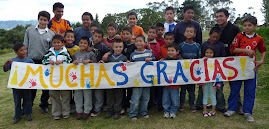 |
| Jordan Garcia adjusting the seat on his bike - using our new Park Tools bicycle vice, which is so convenient. |
Of all the work the children do in the shop, maintaining the bicycles is what most affects them directly. You can imagine that each boy is very interested in the condition of the bicycle assigned to him.
Last December, we received a generous gift of about $500 US from a Baptist short-term team from California for bike parts to fix up the bicycles. Last fall, with all the focus on building things for the fair and other projects, we hadn't kept up with the maintenance on the bikes, so this wonderful gift was very timely.
 |
| Felix and Juan Felipe working on Juan's bike. |
Felix and I decided one strategic move we could make with the help of the donation would be to equip all the bikes for the smaller kids with coaster brake hubs on the rear wheel. The smaller kids tend not to have sufficient grip strength nor sufficient coordination to make other braking systems work well. Also, coaster brakes are very low maintenance, which is attractive when we have so many bikes to take care of.
Ironically, when I went shopping for coaster brake hubs in Bogotá in December, I didn't find any for sale. The retailers said they expected a new supply to arrive in late January. So, after I returned from my trip to the US, I tried again and was then able to purchase 6 new hubs at $31,000 pesos ($17.22 dollars) each, made by Velosteel in the Czech Republic. These hubs are well made - using a Sachs design patented in 1904, but are different than coaster brakes commonly available in the US.
So, we began the process of replacing hubs and in some cases the rims, too, on some of the smaller bikes. I found that the spoke pattern for a 16" diameter wheel has to be different than that on a 20" wheel, because the rim has only 24 spoke holes, instead of 36.
So, we began the process of replacing hubs and in some cases the rims, too, on some of the smaller bikes. I found that the spoke pattern for a 16" diameter wheel has to be different than that on a 20" wheel, because the rim has only 24 spoke holes, instead of 36.
 |
| Kevin Garcia (left) and William Gomez lacing spokes on this new, aluminum, wheel for William's bike |
 |
| Julian Garcia (left) and Alberto (right) working on their bikes |
 |
| Julian Garcia installing the tire on the new wheel for his bicycle |
































